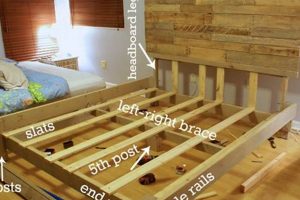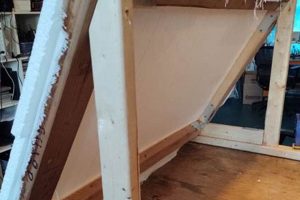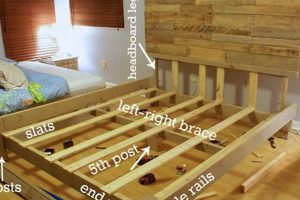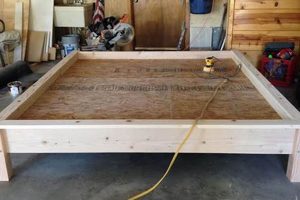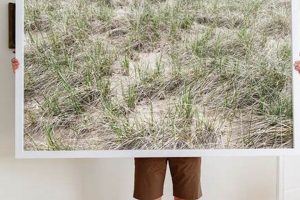Constructing a miniature, unheated greenhouse is a project undertaken by gardeners to extend the growing season. These structures, often built from readily available materials, provide a sheltered environment for plants, protecting them from harsh weather and temperature fluctuations. For instance, reclaimed wood and old windows can be repurposed to create a functional enclosure.
The significance of these garden aids lies in their ability to promote early planting and protect tender seedlings. Historically, these simple structures have enabled growers to cultivate crops outside their natural growing periods, increasing yields and diversifying food sources. This practice fosters self-sufficiency and reduces reliance on external resources.
The following sections will delve into the materials needed, the construction process, and best practices for utilizing such a protective plant enclosure effectively to maximize gardening success.
Tips for Cold Frame Construction and Use
Effective utilization of a homemade plant protector requires careful planning and execution. Adherence to the following guidelines will maximize plant health and structural longevity.
Tip 1: Site Selection: Choose a location that receives at least six hours of direct sunlight daily. Southern exposure is typically optimal to maximize solar gain, essential for warming the internal environment.
Tip 2: Material Selection: Opt for durable, weather-resistant materials such as treated lumber or recycled plastic. Glazing should be transparent and impact-resistant, with polycarbonate or repurposed glass being suitable choices. Ensure all materials are free from toxins that could leach into the soil.
Tip 3: Ventilation: Incorporate a hinged lid or vents to regulate temperature and humidity. Overheating can damage or kill plants; therefore, adequate ventilation is crucial, particularly on sunny days. Automatic vent openers can provide precise temperature control.
Tip 4: Proper Sealing: Ensure all joints and seams are properly sealed to prevent heat loss and protect against drafts. Caulk or weather stripping can effectively minimize air leaks, enhancing insulation.
Tip 5: Soil Management: Use a well-draining soil mix suitable for the plants being cultivated. Amend the soil with compost or other organic matter to improve fertility and water retention.
Tip 6: Pest Control: Regularly inspect plants for signs of pests or diseases. Implement preventative measures such as introducing beneficial insects or using organic pest control methods to maintain a healthy environment.
Tip 7: Water Management: Water plants as needed, avoiding overwatering, which can lead to fungal diseases. Drip irrigation or soaker hoses can provide consistent moisture without excessive leaf wetness.
These practical considerations contribute significantly to the effectiveness and longevity of the structure and the well-being of the plants it shelters.
The subsequent sections will provide further guidance on advanced techniques and long-term maintenance strategies.
1. Material Selection
The selection of appropriate materials is paramount to the success and longevity of any cold frame project. Material choice directly influences structural integrity, insulation capacity, and overall cost-effectiveness. Careful consideration is therefore essential to maximize the benefits of this gardening technique.
- Glazing Material
The glazing material, such as glass, polycarbonate, or polyethylene film, determines light transmission and heat retention. Glass offers excellent clarity and heat retention but is fragile. Polycarbonate is more durable and provides good insulation, while polyethylene film is the most affordable but has a shorter lifespan and lower insulation value. The choice depends on budget, climate, and desired longevity.
- Frame Material
The frame, typically constructed of wood, metal, or plastic, provides structural support. Wood offers aesthetic appeal and is readily available but can be susceptible to rot if not properly treated. Metal is durable and long-lasting but may conduct heat, reducing insulation efficiency. Plastic is lightweight and weather-resistant but may degrade over time. The frame material should be selected based on durability, insulation properties, and aesthetic preferences.
- Fasteners and Hardware
Fasteners, such as screws, nails, and hinges, must be weather-resistant to prevent corrosion and ensure structural stability. Galvanized or stainless-steel options are recommended for prolonged exposure to moisture. The hardware should also be robust enough to withstand repeated opening and closing of the cold frame lid.
- Insulation Materials
Insulation, such as bubble wrap or rigid foam board, can further enhance heat retention, particularly in colder climates. Applying insulation to the interior walls of the cold frame minimizes heat loss and protects plants from freezing temperatures. Proper insulation significantly extends the growing season and improves plant survival rates.
In conclusion, the successful execution of a cold frame project hinges on informed material selection. Each component, from glazing to fasteners, plays a critical role in determining the structure’s performance and longevity. A well-considered selection process ensures a durable, efficient, and cost-effective growing environment.
2. Structural Design
Structural design constitutes a foundational element in the successful construction of a cold frame. The design directly impacts the efficiency of the structure in retaining heat, maximizing light exposure, and providing adequate space for plant growth. Careful consideration of these factors is essential for creating a functional and durable growing environment.
- Frame Geometry and Orientation
The shape and orientation of the cold frame influence its ability to capture and retain solar energy. A sloped design, with the highest point facing south, maximizes sunlight exposure during the day. The angle of the slope should be optimized for the specific latitude to capture the most sunlight during the winter months. This geometry directly affects internal temperature regulation.
- Material Strength and Durability
The selected materials must withstand environmental stressors, including wind, snow, and temperature fluctuations. The structural integrity of the frame depends on the strength and durability of the materials used in its construction. Reinforcement measures, such as corner bracing and secure anchoring, can enhance stability and prevent structural failure.
- Ventilation System Integration
Effective ventilation is crucial for temperature regulation within the cold frame. The design should incorporate adjustable vents or a hinged lid to allow for controlled airflow. The placement and size of these openings must be carefully calibrated to prevent overheating or excessive cooling. Automatic vent openers can provide precise temperature control, mitigating the risk of plant damage.
- Accessibility and Maintenance Considerations
The design should facilitate easy access for planting, watering, and harvesting. Adequate headroom and a properly sized opening are essential for convenient maintenance. The structure should also be designed for ease of repair and replacement of components, ensuring long-term usability.
In conclusion, the structural design is an indispensable aspect of a cold frame project. By addressing considerations such as frame geometry, material strength, ventilation, and accessibility, a durable and efficient growing environment can be created. A well-designed cold frame maximizes plant growth and extends the growing season, demonstrating the importance of thoughtful structural planning.
3. Ventilation System
Effective temperature regulation is critical within a cold frame environment. A properly designed ventilation system is indispensable for preventing overheating, managing humidity, and ensuring optimal plant growth, directly impacting the success of any cold frame project.
- Passive Ventilation Mechanisms
Passive ventilation relies on natural convection currents to exchange air within the structure. Hinged lids, roof vents, and side openings leverage temperature differentials to drive airflow. For instance, a lid propped open during the day allows warm air to escape, preventing heat buildup that could damage tender seedlings. The effectiveness of passive systems depends heavily on ambient temperature and solar radiation levels.
- Automated Ventilation Systems
Automated systems employ temperature sensors and mechanical actuators to regulate ventilation. Wax-filled pistons or bimetallic strips expand or contract with temperature changes, automatically opening and closing vents. These systems provide precise temperature control, particularly beneficial in regions with fluctuating weather patterns. Commercial greenhouses frequently utilize automated ventilation for consistent environmental management.
- Humidity Control and Disease Prevention
Adequate ventilation reduces humidity levels, inhibiting the growth of fungal diseases such as damping-off. Stagnant air promotes pathogen proliferation, while consistent airflow dries foliage and minimizes surface moisture. In humid climates, supplemental fans or strategically placed vents can significantly reduce the risk of disease outbreaks within the cold frame.
- Structural Integration and Design
The placement and size of ventilation openings must be carefully integrated into the overall design. Vents should be positioned to maximize cross-ventilation and promote even airflow throughout the structure. The choice of materials for vent construction, such as durable plastics or corrosion-resistant metals, impacts the long-term performance and maintenance requirements of the system. Well-designed ventilation becomes an integral part of cold frame architecture.
The interplay between these facets highlights the importance of a well-considered ventilation strategy. Whether employing simple manual adjustments or sophisticated automated controls, appropriate ventilation is a key determinant in the health and productivity of a cold frame, demonstrating its pivotal role in extending the growing season and protecting valuable plants.
4. Sunlight orientation
Optimal sunlight orientation is a critical determinant of performance for structures designed to extend the growing season. A well-placed structure can maximize solar gain, leading to increased internal temperatures and enhanced plant growth. Conversely, improper orientation can result in suboptimal conditions, negating many of the benefits.
- South-Facing Placement
Orienting the long axis of the structure along an east-west line, with the primary glazing facing south, maximizes exposure to sunlight during the day. This configuration allows the structure to capture the greatest amount of solar energy, particularly during the winter months when the sun’s path is lower in the sky. This direct solar exposure is essential for warming the soil and air inside, creating a microclimate conducive to plant growth.
- Angle of Glazing
The angle of the glazing relative to the horizon influences the amount of sunlight that penetrates the structure. A steeper angle, typically around 50-60 degrees, is optimal for capturing sunlight during the winter. Adjusting the angle based on latitude can further enhance solar capture, ensuring that plants receive adequate light even during periods of low sun angle. This angled design optimizes light interception and minimizes reflection.
- Shading Considerations
Existing structures, trees, or other obstructions can cast shadows that reduce the amount of sunlight reaching the plants. Careful site selection and consideration of shading patterns are essential for maximizing solar gain. Deciduous trees, which lose their leaves in the winter, can provide shade during the summer months but allow sunlight to penetrate during the winter, offering a natural form of seasonal shading. Removing or pruning obstructions may be necessary to ensure adequate sunlight exposure.
- Reflective Surfaces
Utilizing reflective surfaces, such as white-painted walls or reflective mulches, can increase the amount of light available to plants. These surfaces redirect sunlight onto the plants, particularly in shaded areas. Reflective materials can also help to distribute light more evenly within the structure, reducing the risk of scorching or uneven growth. This technique maximizes light utilization within the growing space.
The interplay between these factors underscores the importance of thoughtful planning. By carefully considering these factors, builders can create a structure that effectively harnesses solar energy, promoting vigorous plant growth and extending the growing season. These deliberate orientation strategies significantly enhance the overall efficacy of the project.
5. Soil Composition
The composition of soil within a cold frame is a critical factor influencing plant health and productivity. The controlled environment necessitates a soil profile optimized for nutrient availability, drainage, and root development.
- Nutrient Content and Balance
The soil must provide essential macronutrients (nitrogen, phosphorus, potassium) and micronutrients (iron, manganese, zinc) in appropriate proportions. Deficiencies or imbalances can lead to stunted growth, chlorosis, or other physiological disorders. Incorporating compost, aged manure, or balanced fertilizers can amend nutrient levels. Testing soil samples allows precise adjustment to meet specific plant requirements.
- Drainage and Aeration
Excessive moisture retention or poor aeration can result in root rot and reduced oxygen availability to roots. Well-draining soil prevents waterlogging while allowing adequate air exchange. Adding coarse sand, perlite, or vermiculite improves drainage. Raised beds or container gardening within the cold frame can further enhance drainage characteristics.
- pH Level
Soil pH influences nutrient solubility and uptake by plant roots. Most plants thrive in a slightly acidic to neutral pH range (6.0-7.0). Testing the soil pH and adjusting with lime (to raise pH) or sulfur (to lower pH) ensures optimal nutrient availability. Specific plants may have unique pH preferences, necessitating tailored soil amendments.
- Organic Matter Content
Organic matter improves soil structure, water retention, and nutrient availability. Decomposed compost, leaf mold, or peat moss provide essential organic matter. Organic matter also promotes beneficial microbial activity, enhancing nutrient cycling and disease suppression. Regular addition of organic amendments sustains soil fertility and supports healthy plant growth.
These aspects of soil composition directly impact the efficacy of a cold frame in fostering plant growth. Tailoring the soil to meet the specific needs of the intended crops is essential for maximizing the benefits of controlled-environment gardening.
Frequently Asked Questions
This section addresses common inquiries regarding the planning, building, and operation of a miniature protective plant enclosure.
Question 1: What is the ideal size?
Size is dictated by available space and the volume of plants intended for protection. A standard dimension for home use is approximately 4 feet wide by 6 feet long, with a height of 1-2 feet. Adaptations can be implemented based on individual gardening requirements.
Question 2: What glazing material provides the best insulation?
Double-walled polycarbonate sheeting offers superior insulation compared to glass or single-layer plastic films. This material reduces heat loss and provides better protection against freezing temperatures. Initial costs are higher, but long-term energy savings and enhanced plant protection justify the investment for colder climates.
Question 3: How is ventilation regulated?
Ventilation is managed through hinged lids or manually operated vents. During sunny days, opening these features allows excess heat to escape, preventing plant damage. Automatic vent openers, triggered by temperature changes, provide a more precise and consistent method of ventilation control.
Question 4: What is the optimal soil composition?
A well-draining soil mix, rich in organic matter, is recommended. A combination of garden soil, compost, and perlite or vermiculite provides adequate drainage and nutrient availability. Sterilization of the soil is advisable to eliminate potential pathogens and weed seeds.
Question 5: How can pest infestations be prevented?
Regular inspection of plants is crucial for early detection. Employing preventative measures, such as introducing beneficial insects or applying organic pesticides, minimizes pest problems. Maintaining good hygiene within the enclosure, including removing dead leaves, further reduces the risk of infestations.
Question 6: How does one minimize heat loss during cold nights?
Insulating the exterior walls with materials like bubble wrap or blankets significantly reduces heat loss. Sealing gaps and cracks with weather stripping also minimizes drafts. Placing water-filled containers inside the enclosure can act as a thermal mass, absorbing heat during the day and releasing it at night.
These answers provide a foundation for informed decision-making in the construction and operation of a protective growing environment.
The subsequent section details maintenance strategies and long-term care recommendations.
Conclusion
The preceding exposition has detailed the multifaceted aspects of cold frame DIY, ranging from material selection and structural design to ventilation, sunlight orientation, and soil composition. Emphasis has been placed on practical considerations and best practices to optimize functionality and durability. Understanding these elements is crucial for successful construction and operation.
Constructing a miniature, protective plant enclosure represents a tangible investment in sustainable gardening practices. Adherence to these principles fosters self-sufficiency, promotes environmental stewardship, and enables extended cultivation capabilities. Thoughtful implementation will yield appreciable benefits, ensuring a rewarding horticultural endeavor.


